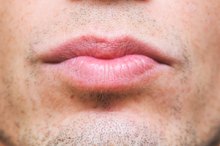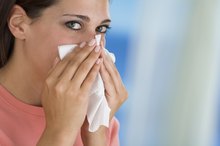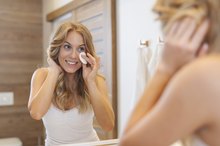Difference Between Rosy Cheeks & Rosacea
Rosy cheeks can be a symbol of a youthful, healthy glow, but for some people, rosy cheeks are the result of rosacea, a skin disorder that causes redness of the facial skin. Knowing the difference between healthy rosy cheeks and rosacea is important, because rosacea may require medical attention. If you are uncertain whether your cheeks are simply rosy or whether you may have rosacea, consult your doctor for a diagnosis.
Location
Rosy cheeks are usually limited to the cheek area. Rosacea can appear on your cheeks, chin, nose, forehead and neck 1.
Patchiness
Food Allergies That Produce a Rash on the Face
Learn More
One of rosacea’s key attributes is its patchiness. Rosy cheeks are usually smoothly pink throughout the cheek area, while rosacea usually appears as oddly shaped pink or red patches. These patches of skin often feel rough or dry.
Pimples
If you have pimples or acne on your face in the areas that are usually red, then you likely have rosacea. Rosacea’s pimples are more subtle than acne pimples and tend to cluster in one or two areas 1.
Lines
How to Get Rid of Freckles With Vitamin C
Learn More
Next time your cheeks are looking particularly rosy, take a close look in the mirror. If you see any reddish lines on your face within the rosiest areas of your cheeks, you are seeing the blood vessels in your cheeks, which is a sign of rosacea.
Swelling or Irritation
Rosy cheeks fill in your face and leave it smooth and glowing, but if your rosy color stems from rosacea, your cheeks can feel swollen and unusual to the touch. You may also experience irritation after consuming spicy foods or spending time in the sun.
Treatment
If you suspect you have rosacea, consult your doctor immediately. Left unchecked, rosacea can turn into an ugly, patchy mess across portions of your face and neck. If you do have rosacea, your doctor can prescribe oral and topical antibiotics to keep your symptoms at bay and prevent them from getting worse. If you have rosy cheeks, keep them well moisturized year-round with a twice daily facial moisturizer as part of your regular skin care routine. If they tend to chap in cold winter weather, carry a moisturizer with you when you go out and apply as needed.
- If you suspect you have rosacea, consult your doctor immediately.
- If you have rosy cheeks, keep them well moisturized year-round with a twice daily facial moisturizer as part of your regular skin care routine.
Related Articles
References
- American Academy of Dermatology: Rosacea: Who Gets and Causes
- National Rosacea Society: Frequently Asked Questions
- Al-balbeesi AO, Almukhadeb EA, Halawani MR, Bin saif GA, Al mansouri SM. Manifestations of ocular rosacea in females with dark skin types. Saudi J Ophthalmol. 2019;33(2):135-141.doi:10.1016/j.sjopt.2019.01.006
- Gallo RL, Granstein RD, Kang S, et al. Standard classification and pathophysiology of rosacea: The 2017 update by the National Rosacea Society Expert Committee. J Am Acad Dermatol. 2018;78(1):148-155.doi:10.1016/j.jaad.2017.08.037
- Han J, Liu T, Zhang M, Wang A. The relationship between inflammatory bowel disease and rosacea over the lifespan: A meta-analysis. Clin Res Hepatol Gastroenterol. 2019;43(4):497-502.doi:10.1016/j.clinre.2018.09.009
Writer Bio
Katie Strzeszewski has been writing professionally since 2003 and holds a Bachelor of Arts in professional writing and English secondary education from York College of Pennsylvania. Strzeszewski spent two years performing computer repair for Geek Squad, currently works for men's clothier Paul Fredrick and is also a competitive West Coast Swing and Hustle dancer.









